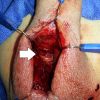Penile Fracture a Complex Case Using The Power of TURNS
The other day I received a request to evaluate a man with a penile fracture. The referral was sent to the office via the FAX machine. Despite being delivered in the routine way, this was no ordinary consult. Penile fracture is one of a handful of urgent cases in urology. My secretary, who is trained to spot unique requests brought it to my attention. I gave her instructions to get him in the very next day so we could investigate the matter further.
Penile fractures are uncommon injuries that are often a result of sexual intercourse. The most common mechanism of injury is when the female partner is on top and the penis slips out of the vagina. The downward force of the female pelvis bends the penis at a severe angle and causes the tunica albuginea to rupture. The tunica albuginea is a tough leathery layer of the penis that traps blood inside, resulting in an erection. When this layer is torn the patient will feel a painful pop, loses their erection, and develops severe bruising. The most effective treatment for penile fracture is a surgical repair at the time of injury. The penis can be conservatively watched but studies show these patients will generally get worse erectile dysfunction and penile curvature when compared to those having surgery.
Here lies the dilemma. Many fractures are repaired a few days after they occur. This happens for a variety of reasons but the most common are delayed presentation due to embarrassment and the time it takes to be evaluated by a urologist for repair. This particular patient presented nearly three weeks after injury when he was told to just watch his injury. He wasn’t getting better and wanted a second opinion. The longest delayed fracture I had personally repaired was around seven days. Not sure if surgery would make a difference, I reached out to my colleagues in TURNS.
While talking to the patient in the middle of clinic, I emailed the TURNS group to get their opinions on this delayed repair. Within five minutes, two members already weighed in. I was able to get a real time opinion from experts located across the country. There was debate amongst the group but the general consensus is that surgical exploration and repair was reasonable.
The patient was taken to the operating room where a small incision was made. Old blood, or hematoma, was drained and large defect was seen:

Figure: Small incision in the penis with drainage of old blood reveals a large tear in the tunica albuginea identified by the white arrow.
The patient’s penis was repaired and was recently seen and found to be functioning normally. The reason I love working with a group like TURNS is the ability to use our collective knowledge to help improve patient care. Now I can share my experience with them so that when the next patient comes in with a delayed presentation, they too can benefit. The cumulative experience and interactions of TURNS experts has the power to change the way medicine is practiced.
